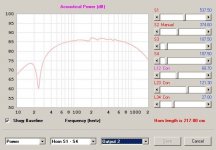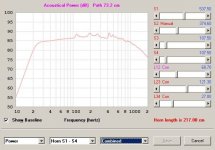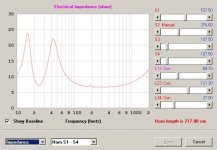I was going to buy DATS so that I could get the "real" T/S paramters for finalising my enclosure design. And then use DATS to get my in-box impedance curves for my XO design.
However after doing some reading, I've decided to just rely on the manufacturer's published T/S parameters.
Which means I would only be buying the DATS for the in-box Impedance testing.
But I have been using REW for quite a few years, and although I haven't actually used it to do impedance testing, I am hoping that I would be able to get reliable results.
Is anyone familiar enough with REW to be able to confirm that REW would give me fairly accurate in-box impedance curves?
However after doing some reading, I've decided to just rely on the manufacturer's published T/S parameters.
Which means I would only be buying the DATS for the in-box Impedance testing.
But I have been using REW for quite a few years, and although I haven't actually used it to do impedance testing, I am hoping that I would be able to get reliable results.
Is anyone familiar enough with REW to be able to confirm that REW would give me fairly accurate in-box impedance curves?
Member
Joined 2003
Sure, using REW or ARTA for impedance measurement is just as reliable as DATS, the method of measurement is exactly the same. In all of these methods, the measurement is a simple voltage divider created by placing a resistor in series with the speaker. DATS is just a USB audio codec with resistor built in.
however, it baffles me that you would want to reply on manufacturer data sheet when you have the ability to measure the driver yourself. If relying on the data sheet, might as well just trace the impedance curve in the sheet, why measure anything?
however, it baffles me that you would want to reply on manufacturer data sheet when you have the ability to measure the driver yourself. If relying on the data sheet, might as well just trace the impedance curve in the sheet, why measure anything?
I am not sure how REW measures impedance, but DATS just guesses from the impedance curve instead of directly measuring it (author), so T/S are not great.
In the box you don’t have T/S you just want to see what the impedance looks like to se eif your alignment is on (hard to do outside a bug anechoic chamber). and looking for resonances you can associate with the box, so i don’t see why either wouldn’t work.
dave
In the box you don’t have T/S you just want to see what the impedance looks like to se eif your alignment is on (hard to do outside a bug anechoic chamber). and looking for resonances you can associate with the box, so i don’t see why either wouldn’t work.
dave
The in-box impedance curve would be handy to verify my enclosure design, but I am assuming the impedance curve of each driver in-box is an essential requirement for XO design (using Xsim), along with the SPL of course.I am not sure how REW measures impedance, but DATS just guesses from the impedance curve instead of directly measuring it (author), so T/S are not great.
In the box you don’t have T/S you just want to see what the impedance looks like to se eif your alignment is on (hard to do outside a bug anechoic chamber). and looking for resonances you can associate with the box, so i don’t see why either wouldn’t work.
dave
But I have to admit that I'm yet to learn and use Xsim. 🙄
My only experience with XO over design was with a DOS version of CalSod (30+ years ago).
Thanks John.
The "M" doesn't stand for Mulcahy, does it? 😉
T/S, as far as i know, play no role in XO design (which i avoid even trying). T/S are (made up) numbers we use to create box alignments with surprisingly high accuracy.
Impedance and FR in box are typically what you use to design an XO, and an XO is no where near the bottom/LF resonant peak(s)* that are the only part associated with T/S parameters.
*(some will try, but if you are that close you are better off bi-amping.)
dave
Impedance and FR in box are typically what you use to design an XO, and an XO is no where near the bottom/LF resonant peak(s)* that are the only part associated with T/S parameters.
*(some will try, but if you are that close you are better off bi-amping.)
dave
Member
Joined 2003
The box only affects impedance at low frequency. It's a "nice to have", but often not a requirement for crossover design. For a 2-way speaker where the crossover is in 2kHz range, impedance change at 100Hz and below has little importance. For a midrange speaker in a 3-way, in-box impedance may affect the high pass filter however. You've nothing to loose by using the in-box impedance for crossover design over the free-air impedance, so by all means go ahead.The in-box impedance curve would be handy to verify my enclosure design, but I am assuming the impedance curve of each driver in-box is an essential requirement for XO design (using Xsim), along with the SPL of course.
Recommend giving VituixCAD a close look as an all-inclusive design tool.
I'm using a Dayton 8" RS225-8 in a transmission line, which will need to be crossed over fairly low to a 3.5" Vifa TC9FD18-08 which is a mid/full range driver in a sealed enclosure. So the crossover is going to be quite low. Using Hornresp, in the TL alignment there are impedance peaks (25ohm) at 15.8Hz and 44.3Hz.The box only affects impedance at low frequency. It's a "nice to have", but often not a requirement for crossover design. For a 2-way speaker where the crossover is in 2kHz range, impedance change at 100Hz and below has little importance. For a midrange speaker in a 3-way, in-box impedance may affect the high pass filter however. You've nothing to loose by using the in-box impedance for crossover design over the free-air impedance, so by all means go ahead.
Recommend giving VituixCAD a close look as an all-inclusive design tool.
I think I have finalised my TL design in Hornresp.Its not going to be crossed below 300 Hz is it?
dave
The left is the driver only and the middle graph is the combined response, and the Impedance is on the right.



The F3 seems to be around 700Hz.
To be honest, I haven't even looked at a crossover design. But so far, I hoping that the RS225 and the Vifa TC9 (in a sealed box) will be easy to cross.
??The F3 seems to be around 700Hz.
F10 looks below 20. F3 is meaningless to humans. F6 is 20. You might have issues with too much room gain.
dave
I am showing how naive I am, but what do you see in my figures that would suggest too much room gain?F10 looks below 20. F3 is meaningless to humans. F6 is 20. You might have issues with too much room gain.
dave
BTW, the room (Living/Kitchen) is 9m (29'6") x 6m (19'7") x 2.4m (7'11") high.
Rockwall on walls and ceiling with light drapes. Concrete floor with some rugs. Quite "bright", no treatment.
The speakers will be away from corners and the baffles will be around 18" from the wall.
That it is fattish amd room gain needs to be added in. A more accurate prediction of real room response is much more difficult. With 8 foot ceilings expect a hump somewhere around 80 Hz. The other dimensions are medius large. There are simplistic room mode calculators to help a bit (“real" dimensions change with windows, openings, how stiff the walls are. Concrete doesn’t move much. How the walls do will depend on the thickness of the drywall and what is behind it.I am showing how naive I am, but what do you see in my figures that would suggest too much room gain?
This is were multiple measurements with something like REW can be helpful… move the mic a bit, the LF response will change.
18” is often sort of as close to the wall as convenient.
dave
Thanks Dave.
We moved house about 10monthes ago.
In the old house I had a purpose built, dedicated home theatre.
I designed and built the room, the treatment, the speakers, the subs, and it was FANTASTIC!!!!!
REW was my best friend. But that build was over 20 years ago.
However the house we are in now does not lend itself to a home theatre, or even has a room that you could turn into a half-decent listening room.
It has a so-called "Media Room", but it is almost square, and too small to really do anything with.
I have now sold all my equipment and the only things I've kept is a CD player, and old Cambridge AR60 amp and a couple of my DIY two-way surround speakers, which currently are connected to the Cambridge amp.
The DIY "surround" speakers are surprisingly adequate for our current simple living room stereo.
However, I've been bitten by the DIY speaker bug again - this time it's really something to keep me occupied.
With such a big gap, I'm having to learn everything again, including using new design tools.
Thank you so much for your patient input.
We moved house about 10monthes ago.
In the old house I had a purpose built, dedicated home theatre.
I designed and built the room, the treatment, the speakers, the subs, and it was FANTASTIC!!!!!
REW was my best friend. But that build was over 20 years ago.
However the house we are in now does not lend itself to a home theatre, or even has a room that you could turn into a half-decent listening room.
It has a so-called "Media Room", but it is almost square, and too small to really do anything with.
I have now sold all my equipment and the only things I've kept is a CD player, and old Cambridge AR60 amp and a couple of my DIY two-way surround speakers, which currently are connected to the Cambridge amp.
The DIY "surround" speakers are surprisingly adequate for our current simple living room stereo.
However, I've been bitten by the DIY speaker bug again - this time it's really something to keep me occupied.
With such a big gap, I'm having to learn everything again, including using new design tools.
Thank you so much for your patient input.
Last edited by a moderator:
- Home
- Design & Build
- Software Tools
- In Box Impedance Testing - DATS v3 vs REW